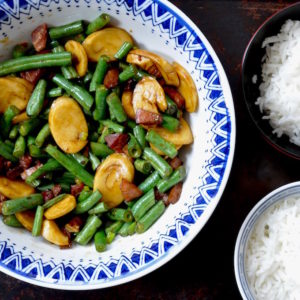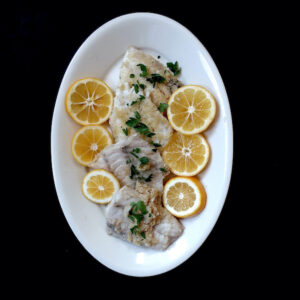Fish Cakes
Before moving to the San Francisco Bay Area in 1998, the closest I’d come to sampling a fish cake was the McDonald’s Filet-O-Fish. I say that without sarcasm.
In 2000 I found work at a large university. My colleagues and I often lunched out. One of our haunts was a Thai restaurant whose appetizer plate included fish cakes. Served with an addictively spicy dipping sauce, those fish cakes were memorably delicious.
Of course, there are other fish cakes out there. The Eastern United States is famed for its crab cakes. I have yet to taste one. And as crabmeat cost $60 a pound last week, I doubt I’ll be sampling one any time soon. This is what people call a first world problem.
The United Kingdom, being an island nation, consumes fish cakes as a matter of course. My many UK cookbooks, both vintage and contemporary, offer dozens of recipes. Among the books I consulted in creating this post were Nigella Lawson’s Feast, which gives a recipe for haddock fish cakes battered with crushed Ritz cracker crumbs, and Diana Henry’s Plentry, which gives a recipe for fish cakes with Moroccan flavors.
Into the kitchen.
As these fish cakes are being fed to my spouse, I seasoned with a light hand, using white pepper, salt, a pinch of smoked paprika, cardamom, parsley, cilantro, and a small garlic clove.

Taking a tip from Thai cooking–specifically, Vatcharin Bhumichitr’s Vatch’s Thai Street Food, I added a few green beans into the ground fish mixture. You can omit these, but believe me when I say they disappear into the mix. I write this as somebody who isn’t overly fond of green beans.

I used a small food processor to grind the ingredients. If you don’t have a small processor, a deep mortar and pestle will work. So will a sharp knife or a blender, but be careful–you aren’t making a smoothie.

If you are preparing larger amounts of fish, a regular processor is fine.

Not the regular processor, but you get the idea.

Fish cakes are often fried, but the idea of cleaning up afterward was unbearable, so I baked mine instead. If you have a deep fryer, have just returned from a yoga retreat, or are generally less decrepit, fry away.

Fish cakes may be large or diminutive. Smaller cakes make nice appetizers, provided people don’t fill up on them before dinner. Larger cakes may be served with pita bread or buns and sandwich condiments. You can also serve fish cakes with tartar sauce, yogurt, or dipping sauce. A few suggestions are given below.

Finally, fish cakes are delicious all by themselves, with lemon wedges and fresh salad greens.
Leftovers, should there be any, keep refrigerated for a day or so–it is fish, after all–or freeze well for about two months.

Fish Cakes
prep time: about 35 minutes
Cooking time: about ten minutes
Serves: 2, easily scaled upward
Please see notes, below, for variations and discussion of fish.
approximately 2 tablespoons fresh cilantro leaves (coriander)
approximately 2 tablespoons fresh parsley leaves
1/2 teaspoon salt
1/2 teaspoon pepper-ideally white, but black is okay
1/2 teaspoon smoked paprika (regular paprika is fine)
1 green cardamom, crushed (optional)
5 ounces/15 grams green beans (about 4), trimmed and cut into slices
scant tablespoon panko or fresh breadcrumbs
1 small garlic clove, crushed (optional)
1 green onion, trimmed and cut into slices
1 half pound-1 pound/225-400 grams white fish fillets
baking spray, canola oil, or other tasteless oil, for the baking tray
You will need a small food processor, mortar and pestle, or sharp knife to make this recipe. I call for a small processor because I made small amounts of fish cake. If you make more, use a standard processor or a blender. You also need a rimmed baking sheet and a bowl.
If you are planning to eat the fish cakes immediately, preheat the oven to 325F/160C. If you wish to freeze the fish cakes, you have two options: freeze the cakes raw or fully cooked. Both methods work.
To cook the fish cakes now, line the baking sheet with tinfoil (for easier clean up) and either spray lightly with baking spray or pour a little oil on the foil.
Place the cilantro, parsley, salt, pepper, paprika, cardamom, green beans, panko, garlic, and green onion into the processor and pulse 3-4 times on high. You want the mixture combined but not liquidized into baby food.
Push the food down with a spatula and add the fish. You may need to do this in relays. Pulse again in three or four pulses on high. If the processor bowl is getting too full, spoon some of the fish mixture out of the processor into the bowl. Add the remaining fish and pulse until ground.
Carefully spoon/spatula the remaining fish mixture into the bowl.
Form the fish mixture into patties and lay them on the baking tray. To freeze now, lay cakes in freezer-safe container or stack them, placing wax or parchment paper between each cake. Wrap in plastic wrap, then aluminum foil, or place stack in Ziploc-style bag. Seal well, then freeze up to two months. Cook from frozen.
To cook now:
Place tray in oven. Bake fish 7-10 minutes. If you’re unsure whether fish is ready, slice into one cake with a fork or knife. Fish should be cooked through. Juices should run clear.
Serve fish cakes immediately with buns or pita, sandwich condiments, salad greens, lemon wedges, tartar sauce, or dipping sauces (suggestions below).
Fish cakes may be refrigerated up to two days or frozen up to two months.
Notes:
Please note: All fish may have bones. Using the food processor grinds up most of these bones, but take care, especially when feeding the young, very aged, or ill diners.
Fish is highly perishable. Cook or freeze it the day you buy it. Do not leave fish out on the counter. Take it out of the refrigerator when you’re ready to use it.
Fresh fish will look and smell fresh. It should not be leaking yellowish, foul-smelling liquid. (A little white liquid is fine.) If the fish looks, feels, or smells bad, throw it out, or wrap it up and return it.
I live in the San Francisco Bay Area, and cook with fish that are local and environmentally sourced. My fish cakes were made from halibut and Petrale sole.
Feel free to season your fish cakes with sumac, ground coriander seeds, ground cumin, cayenne, oregano, mint (Not all together, obviously), or fresh herbs. You can also use Asian ingredients like chopped fresh lemongrass, lime juice, minced Makrut lime leaf, soy sauce, or fish sauce.
If you don’t want to use panko or bread crumbs, consider flour or rice flour.
I oven baked my fish cakes, but if you long to bread and fry yours, I won’t stop you. Fish cakes may also be broiled, sauteed in olive oil or butter, barbecued, or baked in a toaster oven. However you prepare them, fish cakes take minutes to cook.
If you want to serve a dipping sauce, consider your fish cake’s flavor profile first. The recipe given above would pair well with a dipping sauce made with yogurt, lemon juice, crushed garlic, and little hot pepper. You might also try good olive oil mixed with lemon and garlic. Tahini may be added to either of these.
For an Asian flavored fish cake, try a dipping sauce made with rice or Chinkiang vinegar and good soy sauce.





